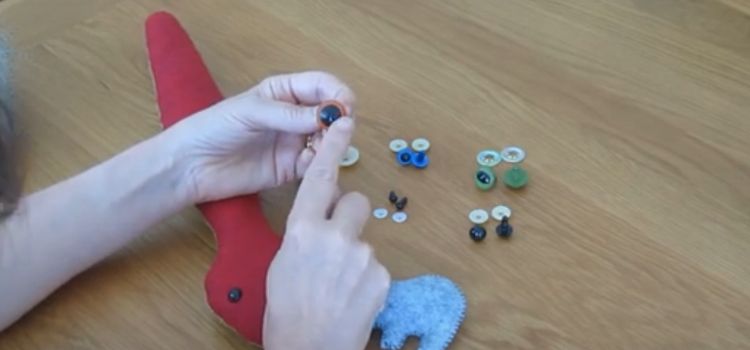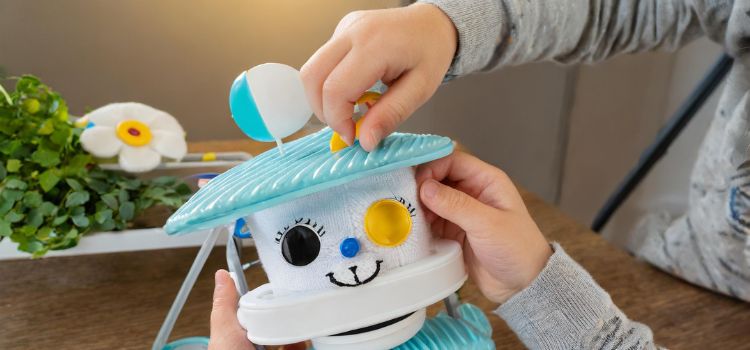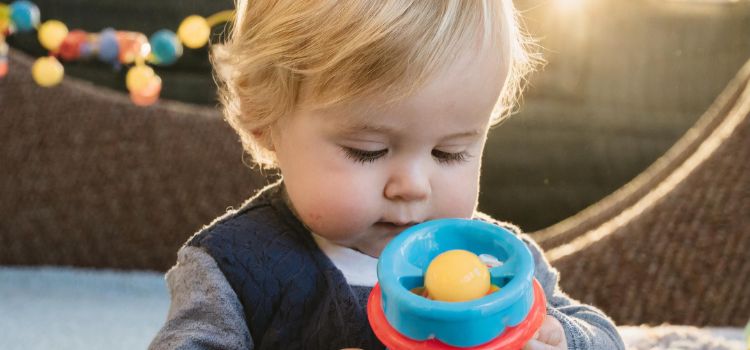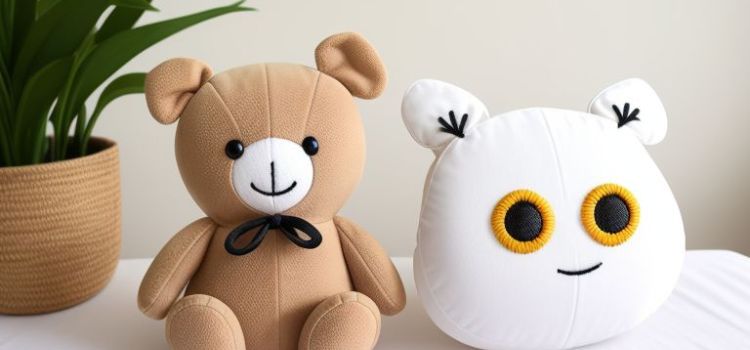
Safety eyes are safe for babies as they are specifically designed with child safety in mind.
As parents, choosing safe toys for our little ones is very important and those cute safety eyes on stuffed animals often catch our attention. These tiny plastic eyes, which are supposed to be safer than traditional buttons, make us wonder—are they really safe?
In this article, we’ll dive into the nitty-gritty of safety eyes, their potential risks, and how they stack up against other options. By the end, you’ll know if these little eyes are the best choice for your baby’s favorite cuddly friend.
So, let’s explore this topic together and make sure our babies’ toys are as safe as they are adorable!
What Are Safety Eyes?
Safety eyes provide a secure option for babies as they are designed to prevent choking hazards. These eyes are safe and secure, giving parents peace of mind while their little ones enjoy their toys.
Safety Eyes Definition
Safety eyes, also known as toy eyes or doll eyes, are small plastic or glass eyes specifically designed for use in baby toys, soft animals, and dolls. These eyes are carefully crafted and constructed to ensure the utmost safety for babies and young children.
Safety eyes are a popular choice among toy makers and craft enthusiasts due to their attractive appearance and secure application.
Use Of Safety Eyes In Toys
Safety eyes are commonly used in handmade baby toys, plush animals, and dolls. They are designed to be securely attached to the fabric or material of the toy without the risk of detachment or swallowing.
These eyes provide a visually appealing and engaging element to toys, enhancing their overall appearance and appeal for babies and young children.
Different Types Of Safety Eyes Available
- Plastic Safety Eyes: Plastic safety eyes are the most common type available and are often preferred for their affordability and durability. They are made from sturdy and non-toxic materials that meet safety standards for baby products. Plastic safety eyes come in various sizes, colors, and designs, allowing for creativity and customization in toy making.
- Glass Safety Eyes: Glass safety eyes offer a more realistic and high-quality look to toys and are favored by some crafters for their aesthetic appeal. These eyes are made from shatterproof glass, ensuring safety even if accidentally broken. Although slightly more expensive than plastic safety eyes, glass safety eyes provide a unique finish to handmade toys.
- Embroidered Safety Eyes: Embroidered safety eyes are a safe alternative for parents who prefer to avoid the use of plastic or glass materials. They are created by embroidering eyes directly onto the fabric of the toy, eliminating any loose parts. This type of safety eyes is particularly suitable for soft and cuddly toys, offering a tactile and child-friendly option.
Remember, when creating toys for babies, it is essential to use safety eyes that are specifically designed and intended for this purpose. By opting for high-quality safety eyes and properly securing them, you can ensure the safety and enjoyment of these toys for little ones.
Common Concerns About Safety Eyes For Babies
The safety of using safety eyes for babies is a common concern among parents. While safety eyes can be safe for babies when used properly, it is important to choose the right size and securely attach them to avoid any potential risks.

Misconceptions About Safety Eyes
Safety eyes are often misunderstood to be harmful for babies, but they are actually designed to provide added security and prevent choking hazards.
Here are some common misconceptions about safety eyes:
- Safety eyes are sharp and can poke the baby’s eyes: Safety eyes are specifically manufactured to have rounded edges, ensuring that they are safe for babies to handle and play with.
- Safety eyes can easily detach and pose a choking hazard: Safety eyes are designed to be firmly attached to toys and other baby products, minimizing the risk of detachment and choking.
- Safety eyes contain harmful chemicals: Manufacturers adhere to strict safety regulations, ensuring that safety eyes are made from non-toxic materials that are safe for babies to use.
Potential Hazards Associated With Safety Eyes
While safety eyes are generally safe, it is important to be aware of the potential hazards that may arise:
- Small parts: Safety eyes are small and can pose a choking hazard if they become detached from toys or other baby products. It is essential to regularly inspect toys to ensure safety eyes are securely fastened.
- Rough play: Babies and young children may engage in rough play, which could lead to safety eyes becoming dislodged or broken. Supervision during playtime is crucial to prevent any accidents.
- Inappropriate use: Safety eyes should only be used in appropriate products and toys that are designed for babies. If safety eyes are used in items that are not intended for infants, they may pose a safety risk.
Safety Regulations For Toy Eyes
Safety regulations ensure that toy eyes meet certain standards to safeguard babies from potential harm. Here are some key safety regulations for toy eyes:
- ASTM F963: This is a standard set by the American Society for Testing and Materials (ASTM) to ensure the safety of toys. Toy eyes need to comply with this standard to be considered safe for babies.
- Choking hazard prevention: Toy eyes are required to meet size requirements, minimizing the risk of them being a choking hazard to infants.
- Non-toxic materials: Toy eyes should be made from non-toxic materials that are free from harmful chemicals, ensuring the safety of babies who may put toys in their mouths.
Safety eyes are safe for babies when used appropriately and in accordance with safety regulations. By understanding the misconceptions, being aware of potential hazards, and ensuring compliance with safety standards, parents can confidently choose toys and products featuring safety eyes for their little ones’ enjoyment.
Expert Analysis On Safety Eyes For Babies
Expert analysis reveals the safety of using safety eyes for babies, ensuring their well-being and protection. Discover how these eyes are designed to meet the highest safety standards and provide peace of mind for parents.

When it comes to the safety of our little ones, it’s important to be well-informed about the products we use. Safety eyes for babies are a popular choice among parents, but are they really safe?
In this section, we will analyze expert opinions on the safety of safety eyes, present research studies on the risks and benefits, and discuss important factors to consider when using these eyes for babies.
Expert Opinions On The Safety Of Safety Eyes
Safety eyes for babies are generally considered safe by experts in the field. These eyes are designed to be securely attached to toys or dolls, minimizing the risk of them coming loose and becoming a choking hazard.
The additional safety feature of a washer or backing ensures that the eyes stay securely in place, even with constant handling and play.
Research Studies On The Risks And Benefits
Several research studies have been conducted to evaluate the safety of safety eyes for babies. These studies have found that when properly attached and used according to guidelines, safety eyes pose minimal risk to babies.
The materials used in safety eyes are often non-toxic and free from harmful chemicals, further ensuring the safety of little ones.
Factors To Consider When Using Safety Eyes For Babies
- Always ensure that safety eyes are securely attached to toys or dolls, as loose eyes can pose a choking hazard.
- Regularly inspect the eyes for any signs of wear or damage. If any issues are detected, replace the eyes immediately to maintain safety.
- Consider the age and developmental stage of your baby when using toys with safety eyes. Supervision is crucial for young children who might still explore objects by putting them in their mouths.
- If you have any concerns about the safety of safety eyes, consult with a pediatrician or child safety expert for personalized guidance.
Safety eyes for babies are generally safe when used correctly and attached securely. It is important to follow the guidelines provided by the manufacturer and regularly inspect the eyes for any signs of wear or damage.
By taking these precautions and considering the developmental stage of your baby, you can ensure a safe and enjoyable playtime for your little one.
Tips For Ensuring Safety When Using Safety Eyes For Babies
Ensure the safety of your baby when using safety eyes with these helpful tips. Keep an eye on the size, securely attach them, regularly inspect for damage, and avoid small parts that can pose a choking hazard. Safety first for your little one!
As parents, it’s natural to prioritize our baby’s safety at all times. When it comes to using safety eyes for babies’ toys, it’s crucial to follow certain precautions to ensure their well-being. Here are some tips to help you use safety eyes for babies responsibly and provide alternative options for their toys:

Precautions To Take When Choosing And Attaching Safety Eyes
- Opt for larger-sized safety eyes: Choose safety eyes that are larger in size to minimize the risk of choking. A diameter of at least 10mm is recommended.
- Ensure proper attachment: Securely attach safety eyes to the toy by following the manufacturer’s instructions. Double-check that they are firmly attached and won’t come loose during playtime.
- Use locking washers or backings: Consider using locking washers or backings to provide an extra layer of security for the safety eyes. This can help prevent them from accidentally coming off the toy.
- Regularly inspect the eyes: Periodically check the safety eyes for any signs of damage or wear. If you notice any loose or broken parts, immediately replace them to maintain the toy’s safety.
Alternative Options For Toys For Babies
- Embroidered or sewn eyes: Instead of using safety eyes, consider embroidery or sewn eyes for your baby’s toys. These can be just as engaging and adorable, while eliminating any potential choking hazards.
- Soft fabric toys: Opt for soft fabric toys that don’t incorporate any small parts. Look for toys specifically designed for babies, with stitched features instead of detachable ones.
- Wooden toys: Explore wooden toys for your little one, as they tend to be sturdier and less prone to breakage. Ensure they are made from non-toxic materials and have smooth edges to prevent any potential harm.
Recommendations For Toy Safety Overall
- Age-appropriate toys: Always choose toys that are suitable for your baby’s age. Check the product labels or guidelines to ensure they are appropriate for your little one’s developmental stage.
- Inspect toys regularly: Regularly inspect your baby’s toys for any wear and tear. Look out for loose parts, sharp edges, or any signs of damage that could potentially pose a risk.
- Keep small parts out of reach: Be mindful of small toy parts, such as buttons or beads, that could be choking hazards. Keep these types of toys out of reach until your child is old enough to safely handle them.
- Follow manufacturer guidelines: Read and follow the manufacturer’s instructions for each toy, including any safety warnings or recommendations. This will help ensure you’re using the toys in the intended and safest manner possible.
Remember, while safety eyes can be a visually appealing addition to toys, it’s essential to prioritize the well-being of your baby. By taking these precautions and considering alternative options, you can create a safe and enjoyable playtime experience for your little one.
Conclusion
In my final thoughts, while safety eyes can make stuffed animals look adorable, our babies’ safety is what truly matters. These little eyes are designed to be safer than buttons, but we parents still need to be vigilant when choosing toys for our little ones.
Picking toys that are meant for babies can really help prevent accidents. Regularly checking toys for loose or broken parts, including those cute safety eyes, is a simple way to keep our kiddos safe.
Ultimately, our babies’ well-being is what counts most. Making informed decisions about their toys is part of our responsibility as parents. By sticking to the advice from toy makers and safety experts, we can ensure our babies have safe and suitable toys for their age.
Leave a Reply